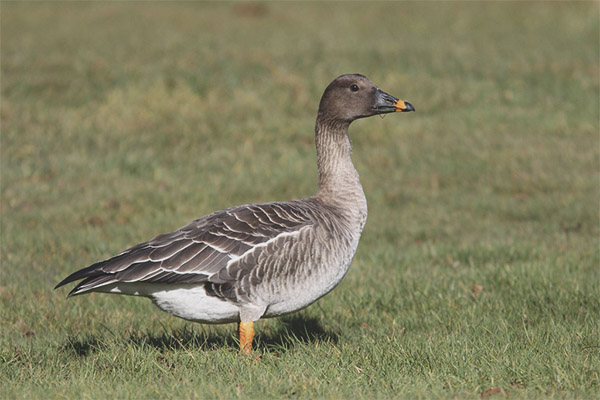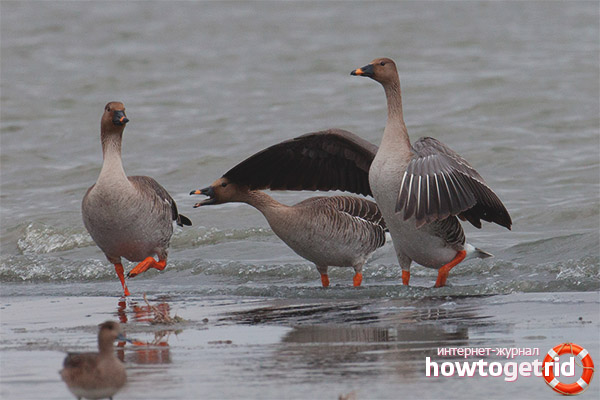The content of the article
Gumennik is a waterfowl belonging to the order of Anseriformes. Note that the birds of this species are quite large in size. The color of the bean goose characteristic brownish-gray shade. One of the distinctive features of the individual is a completely black beak, which in the middle is crossed by a strip of bright reddish-orange hue. The difference between the female and the male of this species is exclusively dimensions. The female is somewhat smaller than the male bean dog.
Natural habitat
The most attractive place for nesting of the bean goose is taiga and tundra. Distributed this type of waterfowl throughout Eurasia. The most preferred places for living are floodplain meadows, characterized by lush vegetation and located in the valleys of large freshwater bodies.Often for their nesting flock of bean beetle choose small forest streams and marshland.
Although this species of birds is not too dependent on water, nevertheless, their main habitat is the area near water bodies, which is explained by the presence of a large number of lush vegetation.
As a rule, the goose bean goose spends most of the day in an open area and only closer to the night it returns to the water. In case of danger, the bird hides in the bushes and high grass, the geese are able to run fast enough, swim with deep diving. For the upcoming wintering, the bean goose chooses a territory within the Eurasian continent, most often it is a coastal sea zone.
Lifestyle
The peculiarity of the species is that it is quite simple to find traces of bean goose, but finding a bird itself in the thickets of grass and shrubs is rather difficult. Birds move very carefully, which is why rarely fall on the hunters sight.
Nutrition
The basic diet of the goose of the bean goose is a diverse vegetable food (berries, plant stems, green bushes). In places of their nesting places, these waterfowl, as a rule, also feed on herbs. During the period of their migration (the onset of cold weather, autumn) geese often make camps on farmlands where cereals were grown (winter wheat, rice).
Although plant food predominates in the diet of adult birds, the boonberry goslings actively use animal feeds: crustaceans, fish roe, mollusks, and small land insects.
In the case of a flock consisting of more adult individuals and young stock, the birds mainly switch to plant food. As a rule, geese rest during the daytime, the feeding period begins either before sunrise or after sunset.
Humenniki are very intelligent and cautious birds, and even when a flock is grazing in a meadow, it’s just impossible to approach it.This is explained by the fact that during the meal they expose observers at the edges of the flock, who, in case of potential danger, make loud enough sounds warning birds about a possible threat.
Breeding of geese
They arrive at their nesting place quite early, as the ground is usually not warmed up, often there is ice and snow on the ground at this time. After arrival, the birds break up into pairs and start creating their own nests. As a place for arranging the nest dry places are chosen near water bodies, secluded corners among willows.
Before construction, the place where the nest will be located is carefully trampled down, after which a small depression is made in the ground. For the base of the bird, as a rule, a variety of dry vegetation is used (leaves, thick plant stems, branches). The walls are built from their own feathers and fluff. Note that the construction of the family house involved both birds - both male and female.
Egg laying (from 3 to 6 pcs.) Is carried out by the female, about 3-4 weeks after the birds arrive at the nesting place.The color of eggs is fawn, in small speck. Hatching is carried out exclusively by the female, however, the male at this time is always near the nest, and in case of any danger, he warns the goose with characteristic sounds.
It should be noted that during the period of incubation of future offspring, geese, in the main, reject their typical behavior, which implies the flight of a bird when a threat arises. Humenniki, instead of the tactics used earlier, hide and hide, masking perfectly, thanks to which they merge with the surrounding landscape.
After the appearance of chicks, adult birds with brood leave the nest, moving to a more comfortable area for living and feeding (flood meadows, islands with abundant vegetation, green shrubs). This area is more preferable for bean goose, not only for food, but also to hide at risk of danger to life.
Nestlings grow quickly enough, with the onset of the molting period, more and more they move to an area with water sources located in it. Young goslings humenniki molt several times a year: in the summer and in the cold season.Shedding in adults - once a year.
The first molt in young goslings begins with the onset of the first cold weather and continues until mid-spring. During the summer molt, the first individuals and geese who do not have a pair begin to change their plumage. For these purposes, they move to safe places inaccessible to humans and animals. As a rule, geese without a pair get together in flocks by the end of the first summer month. At the place of molting, they arrive in early July.
In married couples, the molting period begins after the appearance of offspring. Often the beginning of this period coincides with the movement of the goose family to the water bodies. In some cases, the union of several pairs of geese into a common flock has been observed, and the molt begins in late July.
Economic value
At present, the population of the bean geese is rather modest in size. This is explained by the fact that during the past century this bird has been the object of not only commercial but also sport hunting.
At the beginning of the last century, the mass prey and harvesting of the Gumenniki geese began during the molting period of birds; at this time, adults could not fly far from humans.In addition to the birds themselves, their eggs were also considered the object of fishing. Purified fluff of the bean pudding was used in the textile industry, which was due to its excellent thermal insulation characteristics.
Today, hunting for the goose of the bean goose is prohibited in some regions. Despite this, the population of these waterfowl is recovering very slowly.
Video: bean goose (Anser fabalis)












To send